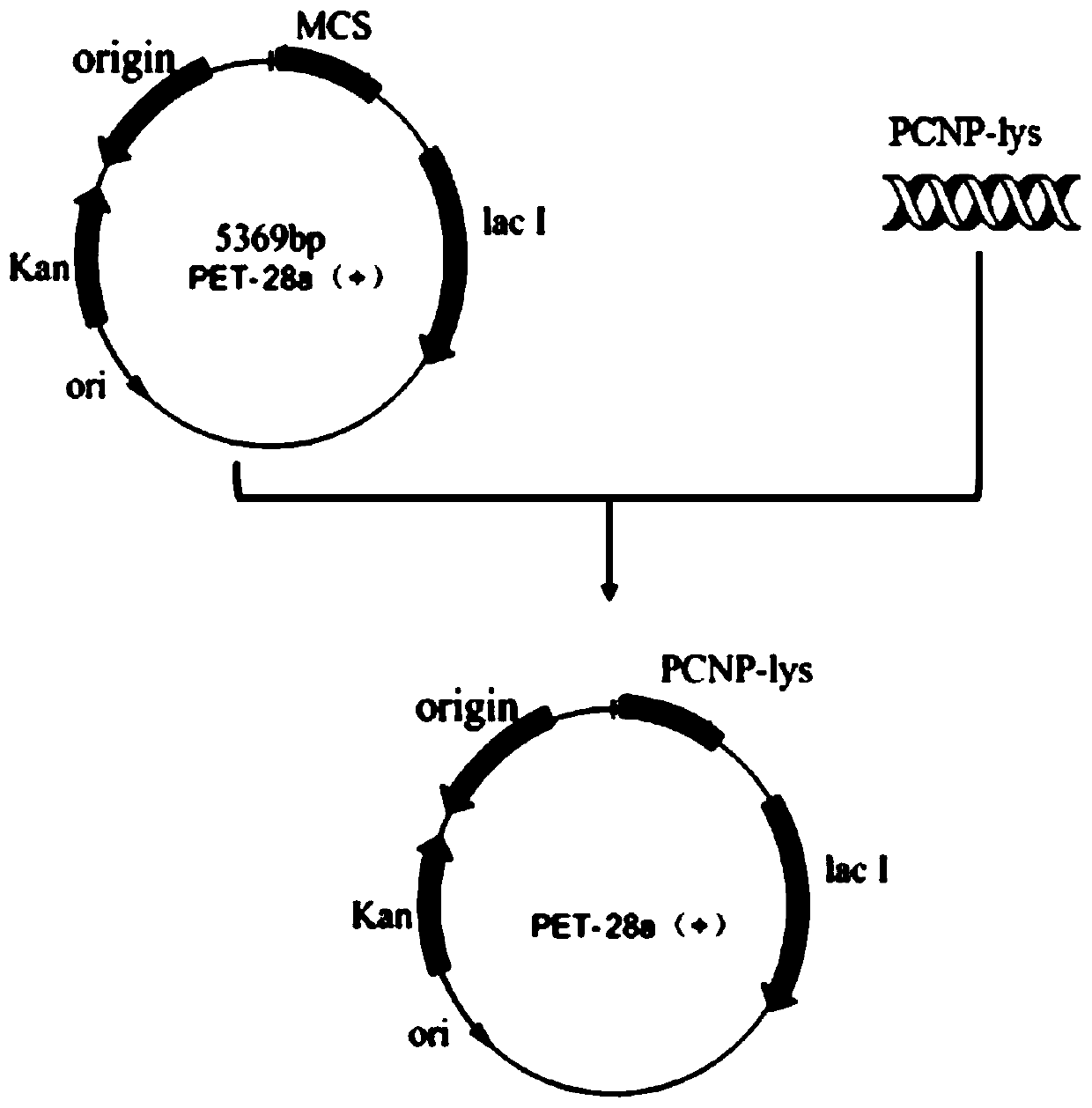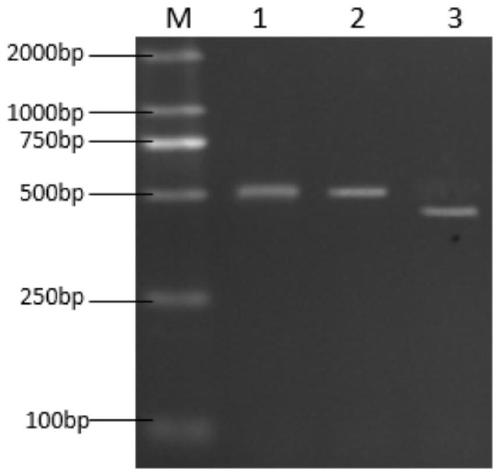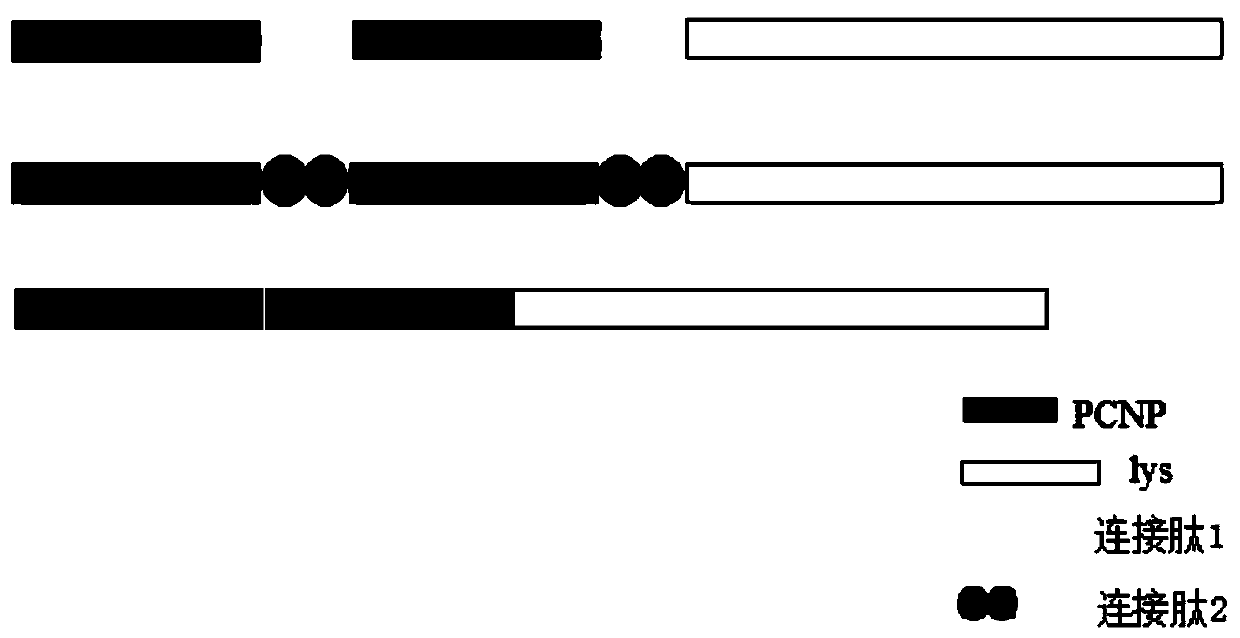Vibrio parahaemolyticus bacteriophage lyase after gene engineering transformation and preparation method and application of vibrio parahaemolyticus bacteriophage lyase
A technology of phage lyase and hemolytic vibrio, which is applied in the field of genetic engineering, can solve problems such as hindering the cleavage of phage lyase, and achieve the effect of improving stability
- Summary
- Abstract
- Description
- Claims
- Application Information
AI Technical Summary
Problems solved by technology
Method used
Image
Examples
Embodiment 1
[0070] Example 1 Amplification of connecting peptide 1 connecting PCNP-lys target fragment
[0071] Step 1, using the Vibrio phage lysing enzyme lys gene (the number in its NCBI protein database is ADX87518.1, and the nucleotide sequence is shown in SEQ ID NO: 20) as a template, use primer 4 and primer 5 to carry out the first PCR, to obtain the target fragment connected with a connecting peptide 1 and the second half of PCNP, and recover the PCR product as the template for the next amplification; then use primer 5 and primer 3 for the second PCR, and obtain a connecting peptide 1 and a complete PCNP target fragment (the purpose of this PCR is mainly to connect the first half of PCNP), and the PCR product is recovered as a template for the next amplification; then the third PCR is carried out with primer 2 and primer 5, and a complete connection is obtained. PCNP and two new target fragments of the connecting peptide 1 (the purpose of this PCR is to connect the connecting pept...
Embodiment 2
[0074] Example 2 Connecting peptide 2 to connect PCNP-lys target fragment amplification
[0075] Step 1, using the lys gene of Vibrio phage lyase (the number in its NCBI protein database is ADX87518.1, and the nucleotide sequence is shown in SEQ ID NO: 20) as a template, use primer 12 and primer 5 to carry out the first PCR, to obtain the target fragment connected with a connecting peptide 2 and the second half of PCNP, and recover the PCR product as a template for the next amplification; then use primer 5 and primer 11 for the second PCR, and obtain a connecting peptide 2 and a target fragment of a complete PCNP (the main purpose of this PCR is to connect the first half of PCNP) to recover the PCR product as a template for the next amplification; then use primer 10 and primer 5 to carry out the third PCR, and obtain a connection with complete PCNP and Two new target fragments of connecting peptide 1 (the purpose of this PCR is to connect connecting peptide 2 for the second ti...
Embodiment 3
[0078] Example 3 Amplification of the PCNP-lys target fragment connected without connecting peptide
[0079] Step 1, using the Vibrio phage lysing enzyme lys gene (the number in its NCBI protein database is ADX87518.1, and the nucleotide sequence is shown in SEQ ID NO: 20) as a template, use primer 8 and primer 5 to carry out the first PCR, to obtain the target fragment connected to the second half of PCNP, reclaim the PCR product as the template for next amplification; then use primer 5 and primer 7 to carry out the second PCR, and obtain the target fragment connected to a complete PCNP (this PCR Mainly connected to the first half of PCNP); the PCR product was recovered as the template for the next amplification.
[0080] Step 2, repeating the step of step 1 successively, obtained the target segment connecting two PCNPs (connecting a new PCNP target segment);
[0081] Step 3, finally use primer 6 and primer 5 to carry out the last PCR (the purpose is to introduce the restric...
PUM
 Login to View More
Login to View More Abstract
Description
Claims
Application Information
 Login to View More
Login to View More - R&D
- Intellectual Property
- Life Sciences
- Materials
- Tech Scout
- Unparalleled Data Quality
- Higher Quality Content
- 60% Fewer Hallucinations
Browse by: Latest US Patents, China's latest patents, Technical Efficacy Thesaurus, Application Domain, Technology Topic, Popular Technical Reports.
© 2025 PatSnap. All rights reserved.Legal|Privacy policy|Modern Slavery Act Transparency Statement|Sitemap|About US| Contact US: help@patsnap.com



